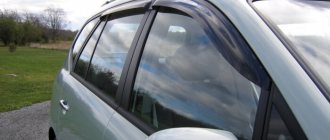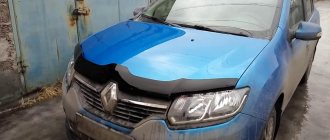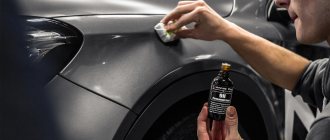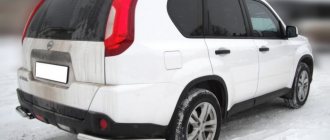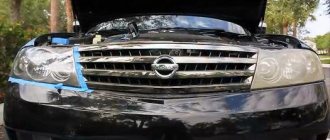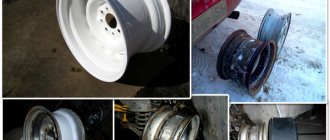Car thresholds (boxes) are one of the most problematic body elements after wheel arches. As a rule, arches, sills, and door edges are often damaged and are most susceptible to corrosion.
To protect thresholds, the following procedures must be carried out:
- internal threshold processing;
- external threshold protection.
Please note that these operations are carried out comprehensively. Internal treatment should be carried out to protect internal (hidden cavities) from moisture. External treatment involves protecting the paintwork of the threshold from chips and other damage in order to avoid the onset of active corrosion. Read more in our article.
Aerosol coating
This method of protecting thresholds with your own hands is the most economical, but not particularly durable. No matter how carefully you apply the product, you are unlikely to be able to achieve a perfect glossy surface, which means that dirt will constantly accumulate in the slightest irregularities, which will eventually lead to the coating peeling off.
- BODY-950. Anti-corrosion spray, which is based on resins. This spray is quite resistant to external damage and dries quickly, but it must be applied using a special gun.
- "Eltrans". The low cost of this anti-gravel aerosol and its application directly from the can make it quite popular among car owners. The product is quite effective and economical in consumption. About 400 grams of product are used per square meter, provided that it is painted in one layer. For greater effectiveness, it is recommended to apply two to three layers.
- Kerry. Quite high-quality protection for car sills, which does not require any special skills to use. Has high adhesion to the surface.
Of course, there are quite a lot of such aerosols, they all have both pros and cons. We have listed the most famous and noteworthy ones. Such threshold protection can also be carried out as an auxiliary in addition to the main methods.
Before starting treatment, the thresholds should be thoroughly washed and dried. If there are traces of rust, they must be removed with a wire brush or sandpaper. And only after that apply the aerosol. If you are using anti-corrosion and anti-gravel protection, then the rust preventative must be applied first.
How to protect car sills from corrosion
No car is immune from rust on the door sills. This problem is familiar to any driver. And if you do not attach any importance to it, then literally a few years will be enough for the thresholds to completely become unusable. Therefore, it is better to take preventive measures against the appearance of rust and carry out anti-corrosion treatment in a timely manner.
Every car enthusiast has wondered how to protect the thresholds of a car, because they are located at the bottom of the car and take the blow of harmful external influences. These are chemical mixtures on the roads, moisture, low temperature and frequent temperature changes. In addition, scratches and chips are caused during movement by all kinds of hard objects such as stones, crushed stone, gravel and sand. These are the places where rust is most likely to appear on your car.
You can protect car parts from corrosion using anti-gravel, and there are both cheaper and more expensive means. They are sold either as protective paint in a metal can or as an aerosol.
The protection can be applied to any coating that is already on the car, that is, primer, paint or varnish. Each vehicle owner decides for himself whether to paint or varnish the treated areas; this choice depends on many factors.
What is the easiest way to protect your car's sills? Apply anti-corrosion agent without subsequent painting. After treatment with anti-gravel, many people re-varnish the surface if they want to get a glossy result. However, you should carefully choose the compositions, because among them there are those that cannot be combined with paint or varnish. After applying the product, an elastic protection in the form of a film is formed on the surface. You should think in advance what kind of result you need.
If you have a question about how to protect car sills from the inside and outside, here is the sequence of actions:
- The process will require the following items:
- the clothes in which you will work (they should be as closed as possible to protect exposed skin from contact with chemicals);
- special gloves (made of rubber);
- glasses to protect your eyes;
- respirator or face covering;
- brush for cleaning metal surfaces;
- sandpaper;
- water;
- the anti-gravel itself;
- degreaser, in particular White Spirit;
- chemical rust converter;
- hair dryer (industrial);
- any material that can be used as a rag.
- Preliminary steps to prepare the car:
- remove protection;
- wash the car well, pay special attention to the thresholds;
- wait for the car to dry, or dry it;
- install the car on an overpass or lift;
- use an emery disc or paper to erase all rusty formations on the surface of the thresholds;
- apply a rust converter to these places;
- treat with a degreasing compound and dry;
- Protect with masking tape areas close to the thresholds, but not intended for treatment.
- Direct treatment with anti-corrosion compound.
There is nothing complicated about how to protect your car's sills, just follow these recommendations:
- be sure to shake the can well before you start spraying, for at least three seconds;
- carry out processing from a distance of 15–20 cm;
- try to work so that the protective agent lies on the surface of the threshold in an even layer;
- after applying one layer, wait about 5–7 minutes, and only then spray the next one;
- in general, at least three layers of protection should be made;
- A hair dryer is needed to make the coating dry faster.
When all layers have been applied and dried, you can remove the masking tape and apply the protection. Before driving out onto the road, it is better to wait a couple of hours for the anti-gravel to dry thoroughly.
[[rlink.166537]
Overlays
Overlays as protection for car sills have not only protective, but also decorative properties. They effectively protect the car from harmful influences and are a beautiful and effective way of tuning.
They are usually made of metal, often chrome, but there are also plastic threshold protections. The last option is the cheapest, but also the most short-lived. In addition, metal can rust much more under a plastic body kit than without it at all. This is due to the fact that if there is no access to air, it “sweats”, and accordingly, the risk of corrosion increases.
Metal linings, on the contrary, are quite durable and reliable.
Generally speaking, a door sill protector is an “entrance mat” on which all street dirt, chemicals from our roads and other debris settle.
Another benefit of using the trim as a threshold protector is that it is very easy to install and replace. There is no need to involve specialists for this. Agree, it is better to periodically change such linings than to subsequently pay for a full repair of thresholds.
As you can see, such protection has many advantages, but there are also disadvantages. Firstly, these are constant additional expenses. And secondly, such linings are not suitable for all car models. Sometimes car enthusiasts complain that after installation it becomes uncomfortable to get into the car - this is especially true for low-slung cars. Well, the third disadvantage is that if you install the trims carelessly, you can deform the body and damage the sills, so all actions must be performed carefully and slowly.
Another option for protecting thresholds is a pipe, which operates on the principle of a threshold plate, but does not require drilling into the body.
How else can you protect your car sills from rust?
There is another way to protect a car, it is less popular because the process is more painstaking and time-consuming. This is a treatment with anti-corrosion mastic.
Before applying mastic, the car is prepared almost exactly the same way as for coating with anti-gravel: that is, it should be washed, dried and treated with rusty spots.
Mastic, unlike anti-gravel, must dry completely on its own, without exposure to a hairdryer. The natural process takes about two hours, and a hairdryer will only soften the composition, causing the coating to dry longer. After waiting the right time, you can install the protection and drive out onto the road.
There are still ways to protect your car's sills. For example, the anticorrosive bitumen product. It is inexpensive and is always on sale in specialized stores. Made from resins and rubber. In essence, it is a cold-applied mastic, but it is better to use Anticorrosive slightly warm: it will become more fluid, and this will increase its adhesive properties. To distribute the product, use the most ordinary brush, and the thicker the layer you make, the longer and more reliably your car will avoid damage.
How else can you protect your car's sills? An alternative option is removable anti-gravel (only available in transparent color), which can be applied and then removed at any time.
The car is prepared for this coating in the same way as in cases with other means. That is, the car needs to be washed, dried and a degreaser applied over the surface. The only difference is that matting is not required. If the question arises of how to protect car sills from the inside, then such disposable coatings are perfect for this. Before applying the product, carefully prepare both the internal and external (with the doors closed) side of the thresholds. There is no need to apply masking tape. The instructions, as a rule, detail recommendations for working with disposable anti-gravel:
- Such compositions should be worked with average humidity and positive temperatures, approximately between 15 and 25 ⁰C.
- The parts to be processed must be washed, dried and degreased.
- The canister with the mixture must be shaken thoroughly.
- Anti-gravel should be applied by holding the sprayer approximately 20–25 cm from the surface to be treated.
As a rule, one layer is not enough. It is necessary to coat the parts with the composition at least twice, or even 4 times. Each layer should be allowed to dry for about half an hour. The final layer should dry longer: up to four hours. When you need to remove the resulting coating, pick up the edge somewhere in the corner and carefully remove it. The process will be easier and simpler if you initially applied several layers, and the resulting film is quite thick.
We recommend
“Stages of engine diagnostics: what determines the sequence of work” Read more
Protective film
This film is used not only to protect the bumper and sills, but also for the entire body, or rather for those parts of it that are most exposed to harmful influences.
Protective film comes in different forms, depending on its purpose. Anti-gravel protection is usually used to protect thresholds.
The advantages of such protection are that installation and dismantling do not cause any damage to the car. In addition, it is quite durable and reliably protects the car from damage. It is quite possible for the car owner to cover the thresholds with such protection. All you need is patience and free time. But if you want to really cover the entire car body with high quality, then it is better to turn to specialists.
The disadvantage of such protection is that:
- Wrapping a vehicle that is not new will make all the chips and scratches on the body more visible.
- If the work is done poorly, there is a high probability that the film will quickly peel off.
- If you do not wash the car, the film quickly turns yellow from dirt.
The film can be vinyl or polyurethane. The first one is short-lived and protects the car only due to its thickness. Quite rough and non-plastic, it can break at low temperatures or with a strong impact. Polyurethane, on the contrary, is quite expensive, but of high quality. Protects not only from minor scratches, but also from sand, stones, etc., it is very elastic and resilient, reminiscent of rubber. Tolerates operation at low temperatures. Polyurethane is approximately five times more expensive than vinyl.
How to protect car sills from scratches and chips
Any vehicle owner will agree that thresholds are one of the most vulnerable places. Many people are faced with the question of how to protect the plastic sills of a car, both from the inside and the outside. A very popular and effective method is pasting with a film specially designed for this purpose. When using it, the machine looks quite aesthetically pleasing, and its parts remain in good condition and do not require repairs or painting. And if you have already come across the terminology “reservation of car thresholds”, then this precisely means protection by gluing surfaces with a special film.
The advantages of this method:
- The film protects the surface from mechanical influences, which cause defects in the form of scratches, cracks, chips and, as a result, rust.
- The protection lasts for quite a long time, at least four years, sometimes even up to seven years.
- After removing the film, you will see that there are no traces left of it.
- This coating does not interact with the paint or varnish with which the car is painted.
- The film is absolutely transparent, it is completely invisible in the places where it is glued.
- There is no need to take additional care of this coating during operation of the machine.
- The surface after gluing the film becomes glossy.
To complete the procedure for booking car thresholds, prepare the following materials:
- Special protective film. The thickness should be selected from 200 microns and above.
- Some kind of liquid soap that does not contain lye. Baby shampoo or Fairy dish detergent will do.
- Container with sprayer.
- Degreaser, such as white spirit.
- A hairdryer for drying, a construction hairdryer is best.
- Well sharpened knife.
- Scissors.
- Squeegee with a soft working edge.
If you have prepared all this, then you already have something to protect the plastic on your car door sills; all that remains is to do the work carefully. The procedure for gluing the film to the surface of parts is absolutely the same as when working with any other films for machines:
- If your car has plastic trim on the sills, they should be removed.
- Then you need to remove any existing contaminants.
- Take measurements to determine which piece of film is needed in terms of shape and parameters.
- You need to cut the piece with a spare allowance along the edges, using a knife or scissors (depending on what is more convenient for you).
- Try on the cut piece, trim more if necessary.
- Walk over the prepared surface of the threshold with white spirit to degrease.
- Fill a spray bottle with liquid soap mixture and spray the thresholds with it.
- Apply the film to the treated areas.
- Heat the film with a hairdryer to glue especially curved areas. This will make it softer, more pliable, so it will be easier to work with.
- Now you need to go over the glued areas with a squeegee on a soft working surface and carefully remove air bubbles and remaining soap mixture from under the film. This procedure is also easier to do if you heat the surface to be treated with a hairdryer.
- Carefully cut off the protruding edges of the protective film.
- Cut through the places where the plastic threshold pads will be mounted.
- Attach the trims removed at the beginning of the process back to the sills.
A special film is something that can be used to protect not only the plastic on the thresholds of a car, but also other structural components of the vehicle: bumper, fenders, headlights, mirrors, door handles, etc.
It is inconvenient to carry out the film booking procedure alone; it is better to call someone to help. Use the hairdryer very carefully: it produces very hot air and there is a high probability of melting the film.
We recommend
“Restoring a car after an accident: stages, choosing a service station, nuances” Read more
Varnishes and mastics
Protecting thresholds in this way is within the power of the car owner himself. The involvement of service station specialists is usually not required. Operating procedure:
- Thoroughly wash and dry the car sills.
- Remove the external thresholds to allow access to all parts that will require treatment. Clean the thresholds from the inside.
- Remove old anti-corrosion coating and peeling paint. If there are traces of rust, they must be cleaned off until undamaged metal appears.
- Degrease the thresholds with acetone or gasoline and apply a rust remover.
- Use masking tape to seal the areas that will not be treated.
- Apply etching primer.
- Treat thresholds with protective agents.
- Leave for two to four hours until completely dry.
For such work the following are most often used:
- Aerosol, bitumen, polymer-bitumen mastic.
- Movil.
- Bitumen varnish.
- Oil-based material with anti-corrosion properties.
- Rubber-based anti-gravel agent.
External protection of car thresholds
In addition to internal protection, thresholds must be treated externally. For these purposes, you can use various means. As a rule, these are the following compositions:
- anti-gravel for thresholds;
- special mastic;
- anti-corrosion agents.
Such coatings can be purchased in aerosol cans; there are also “brush” or “gun” solutions. The protection is applied from above, that is, directly onto the primer, paint or varnish.
- The easiest and fastest way is to apply a ready-made anti-corrosion agent to the thresholds without painting or any additional processing.
- A more complex method is anti-gravel treatment, which can be combined with subsequent coating with paint or varnish to obtain a gloss effect (the main thing is to choose compositions that can be treated with paint or varnish);
- To obtain a durable and thick protective layer, it is optimal to use the method of treatment with anti-corrosion mastic. In this case, the surface will need to be prepared in advance so that the protective coating adheres well to the thresholds.
Another option is a protective anti-gravel armor film on the car, which is glued to the threshold after it has been treated with a suitable composition or painted. This method is especially in demand if you had to buy a threshold and install it on a car, paint the thresholds, after which protection is also required while completely preserving the appearance of the freshly painted element.
Liquid locker
Liquid locker is a dense viscous paste, which, after being applied to the thresholds, hardens and has properties similar to rubber or elastic plastic.
The advantages of this method of protection:
- Resistance to mechanical stress.
- It is quite easy to apply, even to hard-to-reach places.
- The locker is plastic and homogeneous.
- Resistance to moisture protects the car from the accumulation of condensation.
- Environmentally friendly.
- It grips well and has a high threshold of adhesion to the car coating and does not form drips.
- Tolerates high and low temperatures well.
- Has soundproofing properties.
This method of protecting thresholds takes place in three stages:
- Using a brush or spatula, apply the first layer of anticorrosive and dry.
- Apply a second layer of bitumen mastic and dry.
- Spray the third finishing layer of anti-corrosion rubber.
Each layer should be 1.5-2.5 centimeters thick. This coating completely sets approximately two days after application, so it is better to refrain from using the car during this time.
Tools and materials
Processing thresholds from the inside with your own hands involves the use of available aids. Basic tools and materials, their scope of application:
- Overalls. A prerequisite for starting work. Provides for the complete absence of exposed skin, the presence of safety glasses, rubber gloves, and a respirator. Protects against the harmful effects of chemical components of the working compound.
- Wire brush and sandpaper. Serve to clean the metal surface before anticorrosive treatment.
- Rags or old rag. Removes unnecessary elements from the workspace.
- Means for preparing the body for the main procedures, that is, a degreaser, a rust converter, clean water to create the necessary consistency.
- The main product for anti-corrosion treatment of the body.
- Industrial hair dryer for the final drying stage.
- Jack or lift. Additional equipment to improve working conditions in hidden areas of the vehicle underbody.
Specialist services
If your sills are welded to the vehicle body, then you will have to work hard to repair them. If you find minor scratches and deformations, the outer part of the threshold is repaired. First, you need to drill holes in it through which, using special tools, you can penetrate the inside of the threshold. Use them to repair minor breakdowns. If your thresholds are covered with rust, then cutting it off is highly not recommended.
Repairs take place by installing special steel patches. If you do not have welding skills, it is recommended that you contact a professional. Among car owners and repairmen, another method of repairing car sills is common. This requires the use of heavy male power. A rod needs to be welded to the place where the defect is formed. It is recommended to use steel rods, since this material is very durable and will not be damaged during repair work.
Then, by using physical force, or using special devices, we act on the rod, thereby straightening the damage. After completion of the work, it is recommended to remove the steel rod. This method is used in cases where the defects are minor. If your thresholds have more serious damage, then you must take into account that repairing these areas may prompt the removal of the door and seats, as they may interfere with the repair.
Therefore, it is better to avoid more serious damage. If the defects are still serious, then the threshold should be completely changed. The old one is simply cut off using a grinder, and the new one is welded. As we can see, any damage to this element can be repaired. You just need to identify them in time.
Treatment of car thresholds inside and outside
The process of applying anticorrosive agent with a special spray can or a special gun is labor-intensive and requires concentration and preparation. Basic rules for painting a metal surface:
- A layer of protective material is applied evenly over the entire area.
- The distance from the injection site to the body is 15-20 cm.
- After each spraying, drying with an industrial hairdryer is possible.
- The number of layers for optimal results is at least three.
- The holding time between processing phases is at least 5 minutes.
- The auxiliary tape is removed.
- The duration of drying of the car after completion of the procedure before use is at least 2 hours.
When using anti-corrosion mixtures based on mastic, you cannot use a hair dryer. This has the opposite effect. The list and specific gravity of paint components are adjusted to achieve the effect.
The workplace must be adapted and equipped with the necessary equipment, work clothes must be in proper shape, tools and equipment must be in good condition and conveniently located.
Restoring the integrity of a car's paint at a service station is safer than treating car sills against corrosion with your own hands in the garage. But with the necessary skill and concentration, the car owner solves the problem at a minimum cost, and acquires positive experience in operating the car.

